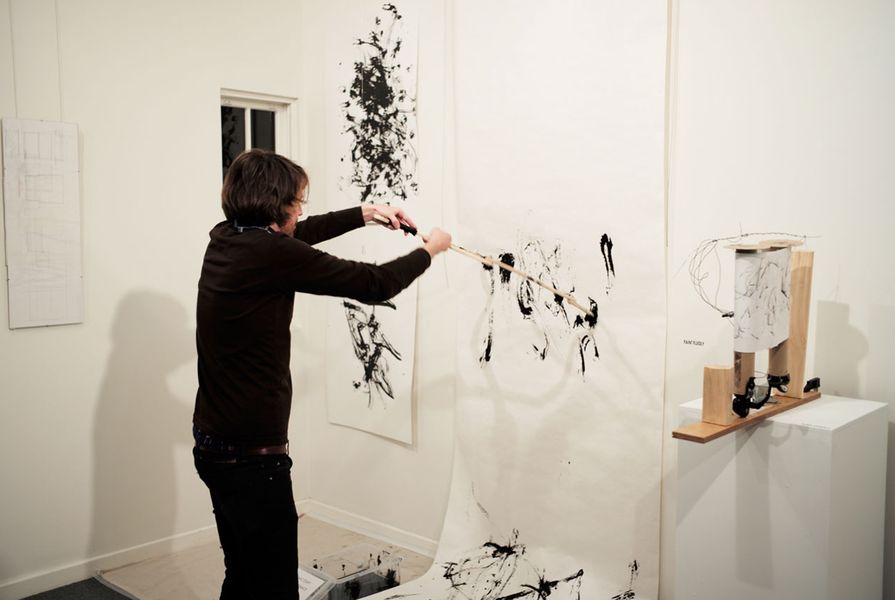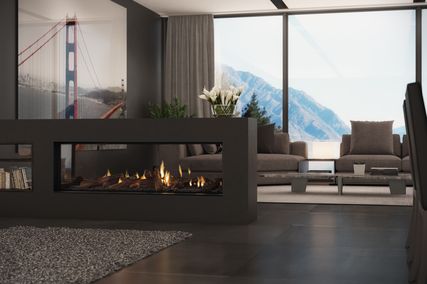Comprising sketching, painting, architectural drafting, rendering, photography and installation, the works of Trace: Architectural Musings negotiate the role of drawing as an art, a process and a practice. Exhibition curators, architect Leonie Matthews and John Curtin Gallery coordinator Amanda Alderson, positioned Trace as an experimental model. Four artists and four architects were invited to explore the nature of drawing without a prescribed medium, nor the need for a definitive outcome.
The qualities of precision and uniformity associated with digitally-produced drawings underpinned the exhibition, together with the comparative liberation ascribed to hand-drawn techniques. The result is a series of musings that reveal the internal and physical essence of drawing. The inquiry into the act of drawing in each work is twofold; firstly, it describes a ‘drawing in’ or internalisation of thoughts and influences, and a ‘drawing out’ of physical material to unpack these ideas. The resulting works, Matthews explains, ‘are the drawings before the drawings – these are the drawings the client will never see.’ The works, therefore, suspend the trajectory of each participants’ creative practice. They offer a tangible moment to observe the varying role that drawing plays in the interrogation and maturation of an idea.
Drawing In, Drawing Out by Drew Penhale and Shane Winter (Penhale and Winter).
Image: Hannah Gosling
For architects Penhale and Winter, Trace offered an opportunity to explore the drawn communication between the architectural duo. Initiated by director Shane Winter’s relocation to Berlin, the project Drawing in/Drawing Out reveals a new way of working, acquired by the passing back and forth of drawings and text. This process involved an exchange between the directors, with each drawing being received, printed, scanned, re-worked and re-sent, enriching and consolidating the project under exploration. The mass of exhibited work illustrates the cumulative material of these transactions. Winter states:
Using the work undertaken across sketch design for the new commission (an alteration and addition to a family home in Mount Hawthorn), we exhibit what at first glance appears to be a set of dry, hardline drawing across three walls of the Mundaring Arts Centre. Located on one wall, a set of measured drawings describes and dissects the anatomy of the existing house through detailed plan, elevation and sectional drawings. Opposite, a corresponding set of drawings illustrates the design proposition. A third wall begins to summarise the work through a key diagram, a bird’s eye and worm’s eye axonometric. Sitting upon a plinth below these pinned up drawings, a booklet contains the email correspondence between the two partners. Read chronologically, it traces the progression of design ideas through personal exchanges and accompanying A3 attachments.
No Anniversary by Jacqueline Ball.
Image: Hannah Gosling
This sense of documenting and re-visiting prior stages of thought is also evident in Jacqueline Ball’s photographic series No Anniversary. Ball describes a process of drawing connections between old photographs, ‘pairing and separating, combining in other configurations’, retracing the images in a new context to discover meaning. This explorative process forges links between photographs and concepts, and between multiple photographs, revealing synergies not previously seen. This ‘drawing with images’, purports ‘drawing’ as a vehicle to derive meaning – consolidating drawing as a process, rather than solely an output. Printed sketchily on an architectural plan printer, the photographs offer a glimpse into Ball’s current discoveries.
Extending this concept, Mundaring Arts Centre’s Gallery 2 became an architectural project space displaying speculative student work. The emerging practices of these student participants further interrogated the role of drawing as a progressive tool for project development. The public program also comprised a mini symposium with participating artists and Open House tours to visit local architectural works.
Bringing together different yet resonant works by artists and architects, Trace rigorously examined the act of drawing. The drawn works provided a compelling interrogation of the subject. In contemplating the act of drawing, each work is conceived as a product of thought, process and practice. The drawings hold a nascent energy that allows others to engage with the process of articulating space.
Partipating artists: Jacqueline Ball, Bevan Honey, Shannon Lyons and Shannon Williamson, with Architects Pia Ednie-Brown, Beth George, Simon Pendal and Stephen Neille (Pendal and Neille), Drew Penhale and Shane Winter (Penhale and Winter).





















